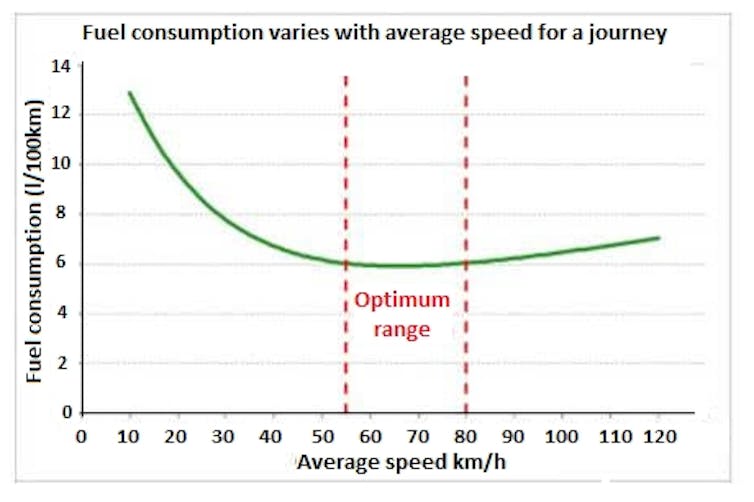Every car has an optimal speed range that results in minimum fuel consumption, but this range differs between vehicle types, design and age.
Typically it looks like this graph below: fuel consumption rises from about 80km/h, partly because air resistance increases.

But speed is only one factor. No matter what car you are driving, you can reduce fuel consumption (and therefore emissions) by driving more smoothly.
This includes anticipating corners and avoiding sudden braking, taking the foot off the accelerator just before reaching the peak of a hill and cruising over it, and removing roof racks or bull bars and heavier items from inside when they are not needed to make the car lighter and more streamlined.
Driving wisely
In New Zealand, EnergyWise rallies used to be run over a 1200km course around the North Island. They were designed to demonstrate how much fuel could be saved through good driving habits.
The competing drivers had to reach each destination within a certain time period. Cruising too slowly at 60-70km/h on straight roads in a 100km/h zone just to save fuel was not an option (also because driving too slowly on open roads can contribute to accidents).
The optimum average speed (for both professional and average drivers) was typically around 80km/h. The key to saving fuel was driving smoothly.
In the first rally in 2002, the Massey University entry was a brand new diesel-fueled Volkswagen Golf (kindly loaned by VW NZ), running on 100% biodiesel made from waste animal fat (as Z Energy has been producing).
A car running on fossil diesel emits about 2.7kg of carbon dioxide per liter and a petrol car produces 2.3kg per liter. Using biofuels to displace diesel or petrol can reduce emissions by up to 90% per kilometer if the biofuel is made from animal fat from a meat works. The amount varies depending on the source of the biofuel (sugarcane, wheat, oilseed rape). And of course it would be unacceptable if biofuel crops were replacing food crops or forests.
Regardless of the car, drivers can reduce fuel consumption by 15-20% by improving driving habits alone – reducing emissions and saving money at the same time.
Fuel efficiency
When you are thinking of replacing your car, taking into account fuel efficiency is another important way to save on fuel costs and reduce emissions.
Many countries, including the US, Japan, China and nations within the European Union, have had fuel efficiency standards for more than a decade. This has driven car manufacturers to design ever more fuel-efficient vehicles.
Most light-duty vehicles sold globally are subject to these standards. But Australia and New Zealand have both dragged the chain in this regard, partly because most vehicles are imported.
New Zealand also remains hesitant about introducing a “feebate” scheme, which proposes a fee on imported high-emission cars to make imported hybrids, electric cars and other efficient vehicles cheaper with a subsidy.
In New Zealand, driving an electric car results in low emissions because electricity generation is 85% renewable. In Australia, which still relies on coal-fired power, electric cars are responsible for higher emissions unless they are recharged through a local renewable electricity supply.
Fuel and electricity prices will inevitably rise. But whether we drive a petrol or electric car, we can all shield ourselves from some of those future price rises by driving more efficiently and less speedily.
This article is republished from The Conversation by Ralph Sims, Professor, School of Engineering and Advanced Technology, Massey University under a Creative Commons license. Read the original article.
Read next: The Whoop fitness band transformed me from sleepy boy to fit boy in two months
Celebrate Pride 2020 with us this month!
Why is queer representation so important? What’s it like being trans in tech? How do I participate virtually? You can find all our Pride 2020 coverage here.
